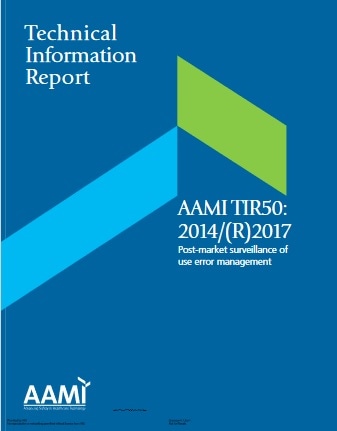AAMI規格 AAMI TIR50, 2014(R)2017: Post-market surveillance of use error management, 使用エラーマネージメントの市販後調査
Description
The guidelines described in this technical information report (TIR) are not separate from or in opposition to the existing U.S. Food and Drug Administration’s (FDA’s) and other regulatory bodies' reporting protocols for product failure or adverse events (concerning morbidities or mortalities), which already have standardized protocols. This TIR focuses instead on a process for handling complaints associated with use errors occurring from medical devices, drug delivery systems and combination medical products. These use errors could be from close calls, user dissatisfaction and/or quality complaints as they relate to use error events and therefore would not normally be reported and evaluated. User dissatisfaction is important, as it can be the source of complaints regarding how devices interfere with the normal workflow and require inappropriate levels of attention. This document recognizes the significant efforts during the pre-market phase to evaluate and improve usability. However, products used in the postmarket environment can provide the largest usability study data set available. This document seeks to enhance the opportunity to have access to such information.
The process described in this TIR is not intended to be prescriptive but instead to provide a framework of guidelines for developing protocols and systems for capturing use errors in order to assure they are available to the appropriate stakeholders. This high-level guidance describes process flow, training and scalability and includes sample questions for data collection. The intended audience of this TIR not only includes manufacturers and clinicians, but also patients, caregivers and other laypersons who would be reporting the events.
Stakeholder entities (not all inclusive)
- Clinicians
- Human Factors and Usability Specialists
- Clinical Human Factors Professionals
- Safety Officers
- Complaint Handlers
- Technical Support
- Customer Facing Personnel (Marketing, Sales, Field Service, Customer Service)
- Product Quality Management (Risk Managers, Quality Engineers)
- Post-market Quality Organizations
- Pharmacovigilance Groups
- Patient Safety Organizations
- Medical Affairs
- Service Organizations (internal and subcontractors)
- Product Development Support/Maintenance Teams
- All Manufacturer Employees (if receiving complaints from customers)
- Manufacturer Usability Practitioner
Reporting entities (not all inclusive)
- Technicians (Biomedical Engineer, Scrub Tech, etc.)
- Laypersons (Patients, Family Members, Caregivers, etc.)
- Clinicians (Nurse, Physician, Therapist, etc.)
Purpose
This document addresses the issue of use error detection for medical devices from the clinical, manufacturer, patient, user and regulatory perspective. The goal is to provide guidance on how these individuals can best collect, assess, and leverage post-market use error data to mitigate product risk, and to improve product safety and usability.
- Manufacturer’s Customer Facing Functions











